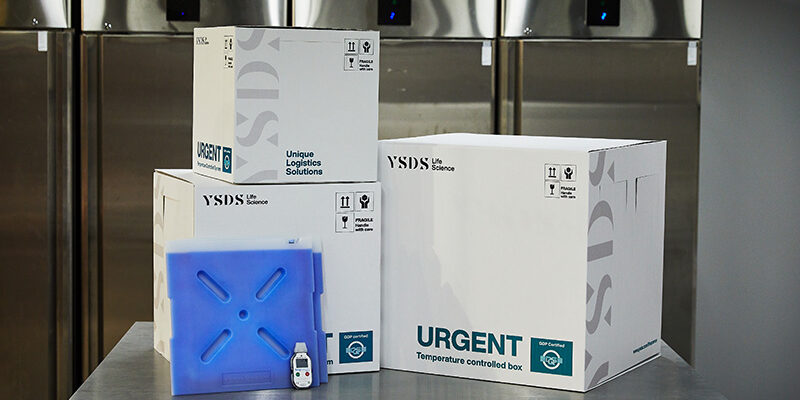With more freight moving around the world than ever, combined with increased external circumstances causing supply chain disruptions, there’s never been such pressure on the success of temperature controlled logistics as there is now. NLS sat down with John Coleman, Business Unit Director at YSDS Life Science, to talk about the challenges of delivering temperature-sensitive goods and how to overcome them.
Anyone can transport goods, but very few can deliver them without a single temperature deviation. You need experience and expertise in temperature controlled logistics.”
Logistics is a complex and vital issue for the Life Science industry. Products must arrive on time, at the right place, in a cost-effective manner. Furthermore, their efficacy, quality and temperature needs to be fully maintained throughout the entire supply chain.
“Just a one-degree Celsius deviation during transportation can cause devastating product and project loss, and ultimately put lives at stake,” says John Coleman. He’s worked with temperature logistics for over 20 years and has seen it all when it comes to transporting temperature-sensitive products.
Temperature deviations during transit are the most frequent reason for product loss. But why do they occur? The answer, in most cases, is customs delays.
“The product gets held in customs, making it impossible for the receiving terminal to keep the product within the correct controlled specific temperature interval. Whilst we can do a lot to minimize the risk of a product getting seized by customs, we can never guarantee that it won’t happen. If it happens, we will have done everything we can to ensure that a temperature deviation won’t occur,” he continues.
Coleman highlights that the most severe risk in temperature logistics isn’t the risks themselves, but the lack of awareness of the risks.

How do you become more risk aware?
“Simply by imagining everything that can potentially go wrong from pick-up to delivery, and planning back-up solutions for every single one of those scenarios. Planning and preparation are the keys to success.”
So what main factors do you need to keep in mind when planning your next transport? We asked Coleman to highlight a few main ones.
1. Training and responsibilities
Without proper training, all other steps will fail.
According to a report by PwC (Shifting patterns – The future of the logistics industry), 50% of the interviewed companies considered the lack of training to be the biggest challenge for transportation and logistics. This is a large percentage, considering all of the other logistical challenges there are out there, but it’s understandable – every person involved in the logistics of a company’s products needs sufficient training to ensure that they can handle all situations correctly and efficiently.
“Transporting goods is easy but executing a flawless transportation of temperature-sensitive products requires knowledge and expertise, for example: when to perform a pickup, which documents and labels to accompany each shipment with, what route, airline and port of entry to use and how to perform a smooth customs clearance process. You also need to know who does what, and when,” John emphasizes.
He recommends the following Life Science logistics trainings: IATA (Freight Forwarder, Dangerous Goods and Security), Good Distribution Practice (GDP) and Risk Management.
“Your employees and/or logistics partner need to be trained and all responsibilities need to be clearly defined and delegated. Many companies I stumble upon don’t prioritize this and hence everything else fails,” he concludes.
2. Knowing your product and planning thereafter
Knowing your product – and planning the logistics in line with its characteristics – is key for a successful transportation.
Coleman explains that before doing anything, it’s essential to understand your product and the requirements around shipping that type of goods.
“After you’ve identified your product’s classification and requirements, you can start planning the logistics. For example: if your product is classified as dangerous goods, you can start planning the right documentation. If your product has a +2 to +8 degree Celsius temperature requirement, you can start planning the right packing solution, etc.,” says John Coleman.
What’s the most common mistake you see people making at this stage?
“Definitely the classification. Goods traded globally are classified by the WCO (World Customs Organization, whose classification system (HS Classification) is used to levy customs duties and other taxes. There’s an array of HS codes – 5 300 in total – and you need to identify the exact one for your product.”
What happens if you classify your product incorrectly?
“Each HS code determines what customs documentation needs to accompany your shipment. Using the wrong HS code leads to producing incorrect customs documentation, which leads to customs seizing your product. This can lead to negative product, monetary and other consequences.”
“When I usually describe HS codes to clients, they scratch their heads in panic! If you have a good logistics provider, there’s no need to worry. Companies know their products better than anyone and are the best at classifying them accordingly, but my recommendation is always to let your logistics provider assist you in choosing the correct HS code.”
3. Demand the highest possible quality from your logistics provider
It’s your logistics provider’s job to meet your needs and desires. Bringing them in as early as possible will allow them to do this to the best possible extent.
Bringing in your logistics provider as early as possible enables them to help you find the most suitable solution based on your preparations and requirements. John Coleman highlights the importance of choosing a logistics provider that is GDP (Good Distribution Practice) certified and being extremely demanding with them.
“It’s our job to meet your needs and desires. It’s as simple as that! Make sure that your logistics provider has planned sufficiently around timing factors that can cause delays or deviations, and that they’ve chosen a packing solution that will keep your required temperature for the whole journey, with good margin,” he says.
What’s important to think about when it comes to timing?
“The general rule is to avoid shipping in connection with weekends because customs activities are much reduced – and in most locations are fully closed – on Saturdays and Sundays. If that’s not possible, you need to discuss with your logistics provider in advance what the best option for you is.”
What type of packing solution should you choose?
“A solution that will keep the required temperature for the whole journey with good margin, so as not to jeopardize your product’s safety. I strongly recommend VIP (Vacuum Insulated Panel) passive systems, as these are extremely stable and can maintain the correct temperature for a long duration of time.”
How do you know if the temperature has been kept for the whole journey?
“By including a temperature monitor, which I always advise. In this way, you get a complete display of what temperatures your product has been exposed to during its journey. Clients are increasingly demanding live trackers, which is a request I highly welcome. Following the location, temperature, humidity, light and even potential shock of the product in real time is a fantastic feature that enables you to directly act on impending deviating activities. My hope is that this will become standard, as it will save so many products and projects in the future.”

4. Invest more
The cheapest and fastest option isn’t always the best one, especially if your product is temperature-sensitive.
Logistics can be expensive and time-consuming, causing companies to prioritize cheaper and faster options. John Coleman means that this strategy can have the reverse effect in the long run: “Don’t jeopardize your whole project by being too cost aware. Investing in the transportation of your goods now will save you money, time and projects in the future.”
In the world of air freight, you usually talk about two shipping solutions: express and commercial.
What’s the shipping solution you recommend?
“Always commercial for Life Science, temperature-sensitive, high value products. It costs more but it’s so worth it. You ship your product with a commercial airline meaning you have less transit points and can create a more customized solution to entirely fit the product’s needs. Furthermore, if something happens during transit, we are able to get hold of the shipment, secure its safety, proactively work around the deviation and still deliver within the planned time.”
“If you’ve chosen an express solution, in which you ship your product with an express carrier, you basically “send and pray”. Once it’s been picked up, there’s no way you can get hold of your product until it’s been delivered. If deviations have occurred along the way, your product will most probably be ruined.”
5. Remember your backup solutions
The difference between a successful shipment and an unsuccessful one is solid backup solutions.
Even if you’ve planned everything down to the last detail, things won’t always go as planned. So-called backup solutions are pre-planned actions you implement should anything go wrong during transit.
How do you know what backup solutions to plan for?
“By asking yourself all the “what if’s” you can think of and making sure you have a solution for every single one. For example, what do you do if your flight is cancelled, your shipment is offloaded for unforeseen reasons or if the dry ice runs out?”
What if the dry ice runs out? What does one do then?
“You make sure that you can replenish dry ice along the way. For example, we had a dry ice shipment from Amsterdam to Boston. Upon arrival in Boston, the product got held in customs because the FDA (Food and Drug Administration) surprisingly wanted to inspect the product’s documentation. The weekend was approaching, and we saw that we needed to replenish the dry ice to maintain the -78°C temperature, but how could we do this? It’s not like the FDA offers dry ice replenishment if they choose to seize a product.”
“We could do it because we had already reached out to our partner in Boston during the planning stage, and therefore knew beforehand that we would be able to replenish dry ice in case the product got held in customs. We had a solid backup solution in place, which we ensured by asking ourselves, “What if we need to replenish dry ice somewhere during transit, will we be able to?” and we made sure that we could.”
Backup solutions are therefore key to a successful shipment, and they need to be planned prior to pick-up. “It’s too late after that!” John Coleman ends.
Conclusions: Shipping your temperature-sensitive products with success

As you assess your temperature controlled logistics strategy for the future, keep these five key tips in mind:
1. Make sure all involved in your logistics process are well-trained to complete their tasks.
2. Know what type of goods you’re shipping and plan in accordance with your products’ and stakeholder’s needs.
3. Bring in your GDP certified logistics provider as early as possible to find the most suitable solution and be extremely demanding with them.
4. Don’t jeopardize your entire project by being too cost aware – always choose VIP temperature-controlled systems and commercial shipping solutions.
5. Make sure that you and your logistics provider have backup solutions in place before the shipment is picked up.
Book John Coleman’s popular talk
John Coleman, Business Unit Director for YSDS Life Science, has worked with temperature sensitive logistics for the past 20 years. With broad experience and expertise in cold chain logistics, quality assurance, risk assessment and clinical trial logistics he knows everything there is to know about shipping your temperature-sensitive products with success.
About the talk
In this 45-minute talk, John Coleman takes you through an assimilated cold chain flow, from planning to delivery. He teaches you how to:
– Create a validated 360 logistics solution
– Avoid customs delays
– Reduce temperature deviations
– Become a master risk mitigator
– Change the way you see logistics
Contact
For booking John to come and speak at your company, or any questions regarding the talk, please reach out to:
Erica Borelius
Head of Communications at YSDS
erica.borelius@ysds.com
About YSDS Life Science
YSDS Science provides global logistics solutions for clinical trials, advanced therapy, biotech, and more. We offer tailor-made GDP-certified solutions for your time and temperature-sensitive products, with full end-to-end visibility. Expect nothing less than 24/7 service from a dedicated team of experts. We offer quality beyond the ordinary.
Visit our website here.
Find your local office here.





